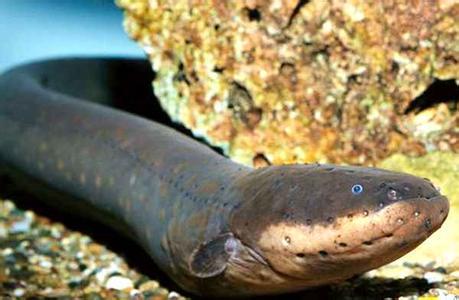(单词翻译:单击)
听力文本
This is Scientific American's 60-second Science, I'm Annie Sneed.
In the 1800s, renowned explorer and naturalist Alexander von Humboldt observed a bizarre incident in the Amazon: he saw electric eels leaping into the air and shocking two horses. But some who heard the story thought Humboldt was a humbug: "Humboldt had described eels attacking horses...but people didn't necessarily believe it." Kenneth Catania, a professor of biological sciences at Vanderbilt University.
But Humbolt was vindicated last year, when Catania published a study showing that electric eels indeed jump in the air to jolt potential predators. This maneuver is the most efficient way for an eel to deliver its shock. When the animal is submerged, electricity is lost to the water. By going airborne "the eel is essentially using that principle of physics to divert more and more current into the target."
But Catania still wanted to know more—like, exactly how strong is an eel's shock to a human? To figure out the forces behind this electrifying leap, Catania used a relatively small eel and a human subject—himself.
"I approached the eel with my hand in a container, which has a metal strip on it. And the eel decided it was concerned about whatever apparent creature might be coming near it...it came out of the water as I planned, up over the metal piece and onto my arm...that allowed me to measure the current flowing through my hand."

After taking various measurements and getting electrocuted 10 times by the eel, Catania discovered that even a small eel can deliver as much as 40 to 50 milliamps of electrical current. That's more than enough to activate the pain receptors and withdrawal reflexes of horses, dogs and humans.
"So I worked around horses when I was younger, and I backed into an electric fence a couple times. It's a good analogy for what the eel is doing...and the animals learn not to touch the fence, and the eel teaches you not to touch the eel."
Catania's new research is in the journal Current Biology. No pun intended.
"It's a really interesting behavior to be able to quantify, basically, what's going on when the eel does this, because it's a unique defense in the animal kingdom." Plus, "This would basically give you a starting point to figure out what would go on with large electric eels in the Amazon." Which, as Humboldt showed, are not horsing around.
Thanks for listening for Scientific American — 60-Second Science Science. I'm Annie Sneed.
参考译文
这里是科学美国人——60秒科学系列,我是安妮·斯尼德。
17世纪时,著名探险家和博物学家亚历山大·冯·洪堡在亚马逊河目睹了一桩奇异事件:他看到电鳗跃到空中,电击了两匹马。但是有些人听到这个故事后认为洪堡在说谎:“洪堡称电鳗袭击了马,可人们不一定会相信。”范德堡大学生物学教授肯尼思·卡塔尼亚说到。
但是去年洪堡的话得到了印证,卡塔尼亚发表的研究显示,电鳗的确能跃到空中电击潜在捕食者。对电鳗来说,这种策略是效率最高的电击方式。电鳗处于水下时,其电力会被水阻碍。而跃入空中时,“电鳗会用物理原理将越来越多的电流转给目标。”
但卡塔尼亚还想了解更多信息,比如一只电鳗电击人类时的电流到底有多大?为了了解这种放电跳跃背后的力量,卡塔尼亚用一只相对较小的电鳗和人类主体进行了实验,而人类主体就是他自己。
“我用装了金属条的手接近容器内的电鳗。电鳗担心靠近它的可能是某种生物,所以它如我预想地那样跃出水面,越过金属块覆在我的手臂上,这使我得以测量流经我手部的电流。”
在进行多次测量并受到电鳗10次“电刑”之后,卡塔尼亚发现,就连小电鳗都能释放高达40到50毫安的电流。这一电流量足以激活马、狗和人类的痛觉感受器和屈肌反射。
“我年轻时做过和马接触的工作,我倒退时曾几次撞上过电网。那和电鳗的行为很类似,动物学会了不要触碰电网,而电鳗教会我们不要去碰电鳗。”
卡塔尼亚的新研究成果发表在《当代生物学》期刊上。此处“Current”不是双关语。
“能量化电鳗所释放的电流非常有意思,因为放电是动物界独特的防御方式。”另外,“这项研究是起点,使我们可以探究亚马逊河大型电鳗的行为。”如洪堡所说,这可不是胡闹。
谢谢大家收听科学美国人——60秒科学。我是安妮·斯尼德。
译文为可可英语翻译,未经授权请勿转载!
重点讲解
重点讲解:
1. figure out 想出;理解;弄清;
例句:It took them about one month to figure out how to start the equipment.
他们花了大约1个月的时间才搞清楚如何启动设备。
2. be able to do sth. 可以…的,能够…的;
例句:I was able to gain invaluable experience over that year.
在那一年里我有幸获得了非常宝贵的经验。
3. go on 进行;发生;
例句:They put a screen in front of me so I couldn't see what was going on.
他们在我面前竖了一面屏风,所以我看不到发生了什么事情。
4. horse around 胡闹;哄闹;
例句:Later that day I was horsing around with Katie when she accidentally stuck her finger in my eye.
那天晚些时候,我正和凯蒂一起胡闹时,她不小心用手指戳到了我的一只眼睛。


